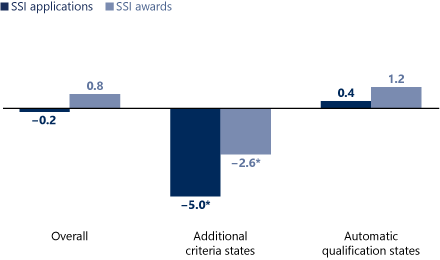The Effects of Children's Public Health Insurance Expansions on Supplemental Security Income Participation
April 2020The CHIP expansion had no effect nationally on children's SSI applications and awards
A 10 percent increase in Medicaid eligibility had no meaningful effect on SSI applications overall. This suggests there is no “welcome mat” effect, where participation in one public program, such as Medicaid or CHIP, increases awareness of and participation in other programs, such as SSI.
However, increased Medicaid eligibility reduced children's SSI applications in states without automatic Medicaid enrollment for SSI awards
For the 18 states where SSI recipients must meet additional criteria to receive Medicaid, a 10 percent increase in Medicaid eligibility led to a 5 percent decrease in children's SSI applications.
For the 33 states with automatic Medicaid enrollment for SSI recipients, the same 10 percent increase in Medicaid eligibility did not meaningfully affect children's SSI applications.

Background
- There is broad interest in the interaction between social programs, including how eligibility changes in one program affect participation in others.
- Around the time Congress passed CHIP, Medicaid eligibility also expanded, and this research explores whether these public health insurance expansions affected patterns of participation in other government programs such as SSI.
Key Terms
- The Children's Health Insurance Program (CHIP) was created by Congress in 1997 to help close health coverage gaps for low-income children whose families could not afford private coverage, but whose incomes were too high to qualify for Medicaid.
- Supplemental Security Income (SSI) is a federal government program that pays benefits to disabled adults and children who have limited income and resources
SOURCE: Levere, Michael, Sean Orzol, Lindsey Leininger, and Nancy Early. 2019. “Contemporaneous and Long-Term Effects of Children's Public Health Insurance Expansions on Supplemental Security Income Participation.” Journal of Health Economics 64: 80–92.
NOTES: All content is simplified for presentation. Please see source material for full details and caveats.
The findings and conclusions presented in this summary are those of the authors and do not necessarily represent the views of the agency.